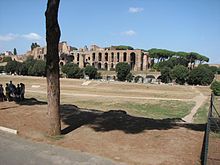- Flavian Palace
-
The Flavian Palace, also known as Domus Flavia, is a part of the vast residential complex of the Roman Emperors on the Palatine Hill in Rome. It was completed in 92 AD in the reign of Titus Flavius Domitianus, more commonly known as the Emperor Domitian,[1] and attributed to his master architect, Rabirius.[2]
Well-known for its grandeur, the Flavian Palace was more commonly used for purposes of state, while the Domus Augustana, an enormous, lavishly ornamented palace south of the Flavian Palace, was the Emperor’s primary residence.[3]
Contents
Layout
It contains several large rooms and suites of rooms; the main rooms are the Basilica, the Aula Regia, the Lararium, and the Triclinium. The Basilica is a group of three rooms and is the first part of the palace visible from the Clivus Palatinus, the road that connects the Roman Forum to the Palatine Hill. The next room is the Aula Regia, one of the biggest rooms in the palace. In the time of Domitian, the walls had a marble veneer, and there were Phrygian marble columns and an elaborately carved frieze. The third room, the Lararium, is the smallest and most poorly preserved room in the palace. Behind it was once a staircase providing access to the Domus Augustana. There were also a peristyle and suites of rooms to the west and east of these three rooms. The Triclinium is the last major room in the palace. Like the Aula Regia, it was large and extravagantly decorated, with Corinthian columns and a frieze. It opened on two courtyards with fountains to the north and south.[2]
The Flavian Palace in contemporary times
The poet Statius, a contemporary of Domitian, described the splendor of the Flavian Palace in Silvae, IV, 2:
Awesome and vast is the edifice, distinguished not by a hundred columns but by as many as could shoulder the gods and the sky if Atlas were let off. The Thunderer’s palace next door gapes at it and the gods rejoice that you are lodged in a like abode […]: so great extends the structure and the sweep of the far-flung hall, more expansive than that of an open plain, embracing much enclosed sky and lesser only than its master.[4]
Scholars usually identify this room as the Triclinium, but it could possibly be the Aula Regia, which was distinguished by its number of columns.[2]
The Flavian Palace was one of Domitian’s many architectural projects, which also included the Domus Augustana, a contribution to the Circus Maximus, a contribution to the Pantheon, and three temples deifying his family members: the temple of Vespasian and Titus, the Porticus Diuorum, and the Temple of the gens Flavia.[2]
References
- ^ The Cambridge Ancient History. Vol. XI. Cambridge: Cambridge University Press, 2000.
- ^ a b c d Darwall-Smith, Robin Haydon. Emperors and Architecture: A Study of Flavian Rome. Brussels: Latomus Revue D'Etudes Latines, 1996.
- ^ Robathan, Dorothy M. "Domitian's 'Midas-Touch'". Transactions and Proceedings of the American Philological Association 73 (1942): 130-144.
- ^ Statius. Silvae IV. Trans. K.M. Coleman. Oxford: Clarendon Press, 1988.
See also
- Domus
- Roman architecture
- List of Roman domes
- List of Greco-Roman roofs
Categories:- Ancient palaces in Rome
- 1st-century architecture
- Building projects of the Flavian dynasty
Wikimedia Foundation. 2010.

